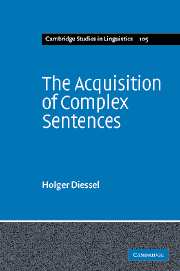Crossref Citations
This Book has been
cited by the following publications. This list is generated based on data provided by Crossref.
Kemmerer, David
2006.
Action to Language via the Mirror Neuron System.
p.
347.
Owen, Amanda J.
and
Leonard, Laurence B.
2006.
The Production of Finite and Nonfinite Complement Clauses by Children With Specific Language Impairment and Their Typically Developing Peers.
Journal of Speech, Language, and Hearing Research,
Vol. 49,
Issue. 3,
p.
548.
Kidd, Evan
Brandt, Silke
Lieven, Elena
and
Tomasello, Michael
2007.
Object relatives made easy: A cross-linguistic comparison of the constraints influencing young children's processing of relative clauses.
Language and Cognitive Processes,
Vol. 22,
Issue. 6,
p.
860.
Donaldson, Morag L.
Reid, Jennifer
and
Murray, Claire
2007.
Causal sentence production in children with language impairments.
International Journal of Language & Communication Disorders,
Vol. 42,
Issue. 2,
p.
155.
Roby, Anna C.
and
Kidd, Evan
2008.
The referential communication skills of children with imaginary companions.
Developmental Science,
Vol. 11,
Issue. 4,
p.
531.
BRANDT, SILKE
DIESSEL, HOLGER
and
TOMASELLO, MICHAEL
2008.
The acquisition of German relative clauses: A case study*.
Journal of Child Language,
Vol. 35,
Issue. 2,
p.
325.
Kidd, Evan
and
Holler, Judith
2009.
Children's use of gesture to resolve lexical ambiguity.
Developmental Science,
Vol. 12,
Issue. 6,
p.
903.
van Veen, Rosie
Evers-Vermeul, Jacqueline
Sanders, Ted
and
van den Bergh, Huub
2009.
Parental input and connective acquisition: A growth curve analysis.
First Language,
Vol. 29,
Issue. 3,
p.
266.
Nippold, Marilyn A.
2009.
School-Age Children Talk About Chess: Does Knowledge Drive Syntactic Complexity?.
Journal of Speech, Language, and Hearing Research,
Vol. 52,
Issue. 4,
p.
856.
EVERS-VERMEUL, JACQUELINE
and
SANDERS, TED
2009.
The emergence of Dutch connectives; how cumulative cognitive complexity explains the order of acquisition.
Journal of Child Language,
Vol. 36,
Issue. 4,
p.
829.
Colletta, Jean-Marc
Kunene, Ramona N.
Venouil, Aurélie
Kaufmann, Virginie
and
Simon, Jean-Pascal
2009.
Multimodal Corpora.
Vol. 5509,
Issue. ,
p.
54.
Nippold, Marilyn A.
Mansfield, Tracy C.
Billow, Jesse L.
and
Tomblin, J. Bruce
2009.
Syntactic Development in Adolescents With a History of Language Impairments: A Follow-Up Investigation.
American Journal of Speech-Language Pathology,
Vol. 18,
Issue. 3,
p.
241.
DONALDSON, MORAG L.
and
COOPER, LYNN S. M.
2009.
Children's production of verb-phrase anaphora in a spoken task.
Journal of Child Language,
Vol. 36,
Issue. 2,
p.
449.
Kirjavainen, Minna
Theakston, Anna
Lieven, Elena
and
Tomasello, Michael
2009.
`I want hold Postman Pat': An investigation into the acquisition of infinitival marker `to'.
First Language,
Vol. 29,
Issue. 3,
p.
313.
Ravid, Dorit
and
Berman, Ruth A.
2010.
Developing Noun Phrase Complexity at School Age: A Text-Embedded Cross-Linguistic Analysis.
First Language,
Vol. 30,
Issue. 1,
p.
3.
ARNON, INBAL
2010.
Rethinking child difficulty: The effect of NP type on children's processing of relative clauses in Hebrew.
Journal of Child Language,
Vol. 37,
Issue. 1,
p.
27.
François, Jacques
2010.
Trois monographies récentes sur les parcours de grammaticalisation et la linguistique de l'usage.
Syntaxe & Sémantique,
Vol. N° 11,
Issue. 1,
p.
185.
Klein, Harriet B.
Moses, Nelson
and
Jean-Baptiste, Rachel
2010.
Influence of Context on the Production of Complex Sentences by Typically Developing Children.
Language, Speech, and Hearing Services in Schools,
Vol. 41,
Issue. 3,
p.
289.
Sánchez-Naranjo, Jeannette
and
Pérez-Leroux, Ana T.
2010.
In the wrong mood at the right time: Children’s acquisition of the Spanish subjunctive in temporal clauses.
Canadian Journal of Linguistics/Revue canadienne de linguistique,
Vol. 55,
Issue. 2,
p.
227.
Owen, Amanda J.
2010.
Factors Affecting Accuracy of Past Tense Production in Children With Specific Language Impairment And Their Typically Developing Peers: The Influence of Verb Transitivity, Clause Location, and Sentence Type.
Journal of Speech, Language, and Hearing Research,
Vol. 53,
Issue. 4,
p.
993.



